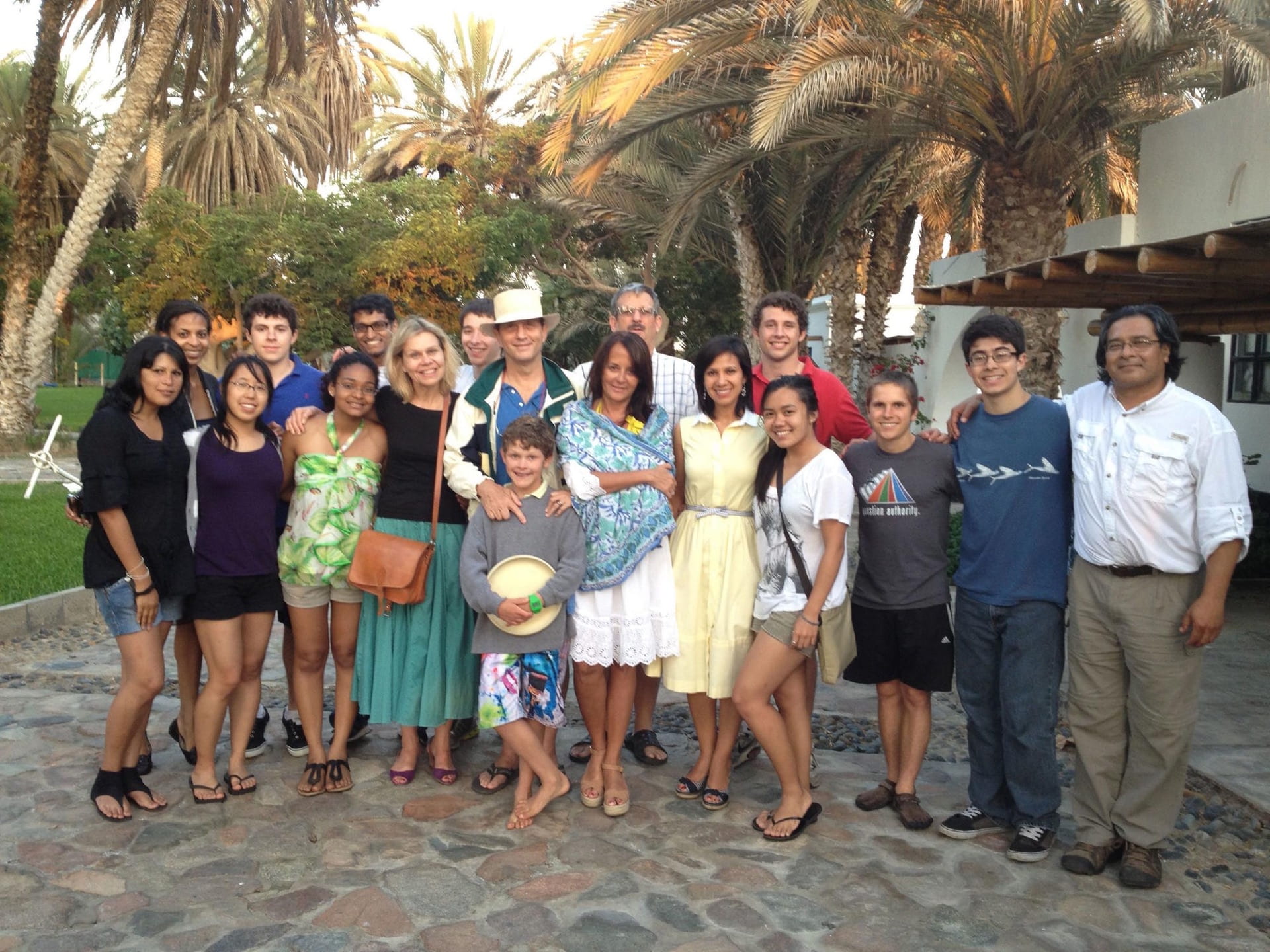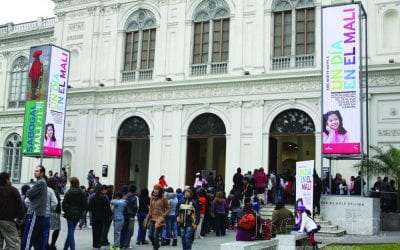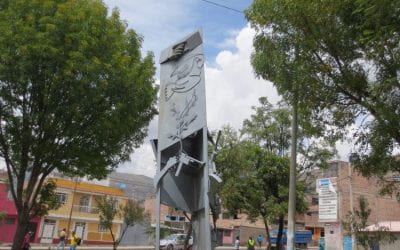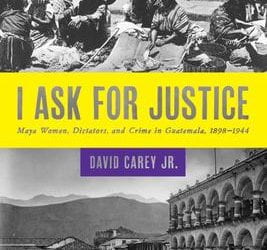A Taste of Lima
Gastronomy and Cultural Identity

Students with Tony Custer (with hat) and Johanna Liander (in long skirt). Photo courtesy of Johanna Liander.
Each one of us has a grandmother or mother, grandfather or father whose dish—humble or elaborate—transports us back in time or space, surrounds us with people, places, images, languages, and even fragrances of the past. The dish—or the memory of the dish—evokes a smile, or perhaps a tear, and generally seems inimitable by those who share the memory. Whether the dish is meatballs, empanadas, cardamom bread or rice pudding, the effect is much the same.
Each nation also has a culinary memory and foundation, dishes recalled and dishes reconstructed that gradually, sometimes mysteriously, become part of the imagined nation and its borders. A country like Spain is transparent, revealing immediately that its cuisine is a result of a history of invasions, expansions, immigration and (of course) globalization. Argentina’s cuisine, too, reflects history, but also geography and distance. (You are never in Buenos Aires de paso, after all, except to Uruguay, which shares rivers, pampa and cuisine…) Yet in Peru, cuisine—of coast, mountains and jungle—has now united a people, who may easily have remained divided by natural and political obstacles. And fortunately for all of us who have landed and lingered in Lima, once called by U.S. novelist Herman Melville “the strangest, saddest city thou canst’ see,” but now is a subtly charming—albeit massive at nine million—metropolis, grey 11 months of the year, and the Aleph of all those enticing and local flavors and ingredients and naturally, too, their accompanying history.
Lima for me would be like Toledo once was for Peruvian writer Julio Ramón Ribeyro, who described that city as one he loved as a passing tourist for its monuments, climate and people—unlike Paris and Lima, where Ribeyro simply felt he belonged, beyond expressing likes or dislikes. Lima does not “belong” to me; I have not lived there for twenty years, only for one long delirious weekend of introduction, and subsequently two January stays: just enough to reveal that I enjoy the city immensely, am fascinated by its history, its people and (of course) its infinite culinary offerings. I can speak of moments visiting plazas, archaeological sites, kitchens and restaurants, private homes and gardens, schools and orphanages, restaurants, markets and museums; and I can recall many conversations, overheard or my own. I have traveled through the insane traffic on Lima’s streets, through districts called Magdalena del Mar, Pueblo Libre, Miraflores, Barranco, Chorillos, Gamarra, La Victoria, and La Molina. And I can say me gusta, I like it, very much.
Lima is not glamorous, nor does it have the street life of Mexico City, nor the beach scene of Rio, yet it is elegant and dynamic. As an Argentine friend once declared, “Here in Buenos Aires, we don’t have a sense or a presence of history…whereas if you walk around Lima, everything is history, you’re completely surrounded by the past!” The limeños might simply say “500 años de fusion,” five hundred years of fusion as past and present, city and provinces collide and cohabit Peru’s capital city overlooking the Pacific. History, art, ethnicities and the country’s biodiversity are all recognized and represented in Lima.
I went to Peru with gastronomic and linguistic curiosity. I went to discover the fruits of the jungle and the culinary treasures of the Peruvian Pacific. And I had heard that the Peruvians “spoke in poetry.” Although majestic in photos, Machu Picchu was not in my plans. I wanted to listen, to speak and to eat, and, as always, my destination was essentially urban. And I came to realize I was in luck, as Lima, thanks to the last 20 years of Peruvian history and politics, is now a city which could and would provide me a sample of the entire country, historically, linguistically and gastronomically.
Lima and Spanish 30
My students’ enthusiasm over our Peruvian readings and activities in one of my advanced Spanish language classes had been overwhelmingly contagious. While reviewing subjunctive clauses, my mission was to introduce aspects of a culture and nation virtually unknown to the undergraduates: to assign active research projects and to read stories and newspaper articles, that would reveal the history, arts, vocabulary and biodiversity of Peru. Later we watched interviews with Gastón Acurio, “the most famous chef in Latin America,” and videos, which introduced Peruvian cuisine, a compendium of what was discussed in earlier classes. Subsequently a local Peruvian chef came to class to solidify our knowledge, presenting, preparing and providing us with samples (in Harvard language classes!) of the delights of the Peruvian table. Students finally had to envision their own Peruvian meal and create a menu to be displayed to the public in Harvard’s new Arts29 space.
The next step was “Lengua, cultura, gastronomía y trabajo social,” a three-week program that I designed and directed, sponsored by the David Rockefeller Center for Latin American Studies in January (2012 and 2014) in Lima, with ten students, experiencing Spanish immersion through homestays, excursions to historical sites, lectures by academics at the Catholic University (PUCP) and by chefs at Cordon Bleu, and hands-on cooking classes, as well as visits to restaurants, fish markets in Callao, pisco liquor factories in Pisco and nature reserves in Paracas. Spanish language and gastronomy were combined with community service: working with young children in impoverished neighborhoods, in the hope of participating more fully on our short stay in Lima.
Lima in Brief
The center of Lima, founded in 1535 by Francisco Pizarro as La Ciudad de los Reyes, was at one time capital of a viceroyalty from Bogotá to Buenos Aires. Today, although not walking distance from the craggy and now fashionable Pacific coast (once harboring pirates), where urbanites might tend to reside, the center is certainly worth a visit, if not several. The magnificent Plaza de Armas, with its grand cathedral and Palacio de Gobierno, all commissioned by Pizarro, is also bordered by brilliant ochre buildings, visible even through Lima’s notorious and seemingly permanent garúa, or fog.
Nearby the historical Bar Cordano, founded in 1905, is known for dishes such as bistec apanado con tacu tacu (breaded fileted beef with a panfry of rice, lentils and a variety of other ingredients, of African slave origin, but with a Quechua name meaning “mixing one thing with another”) and their butifarra sandwich (sliced ham, bearing no resemblance to the Catalán sausage). The Cordano, said to be located at the same corner where centuries earlier Bolívar and San Martín met to plan the liberation of Peru from Spain, is also known to serve “bohemians, intellectuals and all the past presidents of Peru” (apparently three separate categories).
Other such closed doors worth opening for visual feasts are those of the private Museo Pedro de Osma in the Barranco district—once a summer resort—just down the street from the Asociación Mario Testino (MATE) now exhibiting the hometown photographer’s stunning Peruvian work, after years of portraits of British royalty and Vogue supermodels.
Mario Testino is, in fact, another example of the once hidden international presence of Peru, now appearing publicly Peruvian. For the last 20 years Peruvians have been reexamining and reassessing their history and identity, their image, their cultural unity, both at home and abroad: witness the recent national excitement and pride over Peru’s fusion cuisine, as well as Lima’s cleaned and restored center (with the last statue of Pizarro removed and replaced by a flag of the Quechua “Inca Nation”), and Testino’s Alta Moda—a series of photographs of Peruvians wearing traditional dress from Cuzco.
Cooking and History
Of course, another treasure of Peru’s history is the Huacas and the larger archaeological sites. A trip to the pre-Columbian and pre-Incan ruins at Pachacamac (17 pyramids completed between 800 and 1450 AD) will duly impress, and even more so with an added visit to Kusina Pachacamac to experience a pachamanca, an indigenous, mainly mountainous feast of meats, herbs—such as huacatay, paico, chincho and muña—and tubers, all cooked in the pacha, that is, in the earth, with layers of hot rocks. And within Lima, at the Huaca Pucllana, we find an extensive archeological dig of a Wari ceremonial center, and a very high-end and delicious restaurant, both in the fashionable Miraflores neighborhood.
So food is not only a central part of Peru’s history and identity, it is also always accompanied its very own particular story.
It is not surprising that even outside Peru one often finds Japanese-Peruvian restaurants, as ever since the first Japanese arrived in Peru in 1899, they have continued to influence the Peruvian table. Ceviche and miso soup with milk are two common dishes representing the fusion of the two cuisines. Ceviche existed before the Japanese arrived in Peru, but the Japanese would prepare and eat it soon after marinating, rather than allowing the traditional lengthy sit in the lime juice, and they also created tiradito, a ceviche served with filets of fish, modeled on sashimi. Likewise miso soup is Japanese, but the addition of milk is entirely Peruvian. Yucamochi, a dessert made from yucca, milk, sugar and cinnamon baked in the oven, has its origin in a similar Japanese dessert (mochi) made with rice.
The Japanese were delighted with the variety and quality of the seafood and seaweed found in the Peruvian Pacific, and it is said that the Peruvians are always open to new foods. The Japanese taught the Peruvians to eat crab, octopus and pota (giant squid). Nikkei cooking is Japanese cooking, but created in Peru. The origin is an immigration classic: fleeing a farming crisis, around 700 Japanese landed in Callao and they first worked growing and cutting sugar cane. Their marriages were arranged back home, and their young wives (very young: 15 and up!) knew nothing about cooking. They tried to recreate flavors from home with Peruvian ingredients, and slowly Nikkei cooking was born. Lucky for all of us, especially my group this past January!
We should also mention the most beloved of Peruvian dishes for Peruvians, ají de gallina, a chicken stew with a spicy, creamy and nutty sauce made from both yellow and mirasol peppers, bread, cheese and nuts. Everyone claims their mother’s version is the best, but my students from 2012 and I know that Tony Custer’s version outshines the rest. It is served with white rice, yellow potatoes and boiled eggs.
My friend Isabel Alvarez, sociologist and owner of my favorite restaurant in Lima—who will remind us that Peruvian cuisine is based on potato, corn, rice from the Chinese, and lemon (lime) from the Spaniards—has traced the development of the ají de gallina, which apparently was originally Spanish and contained sugar. That is, the 16th-century sevillanos used to eat a sweetened chicken stew, which upon crossing the Atlantic—and the Andes—was recreated into two dishes: one savory with Peruvian peppers (ají de gallina) and the other, probably the most beloved sweet for all of Latin America (manjar blanco, manjar, dulce de leche, arequipe…). And thus was created the most important ingredient in a dessert greatly favored by this author and Paddington Bear, the alfajor. Both Paddington and I miss these heavenly morsels when far away from South America; Paddington Bear was, of course, from “deepest, darkest Peru.”
Sixty percent of Peru’s land is jungle, alas far from Lima. Yet the students and I devoured its fare—juanes (tamales made with rice, no relation to the Colombian singer) and lulo, camu camu, aguaje and other fruits—at markets and at the Cordon Bleu this past January. Paiche, the largest freshwater fish in South America and chonta salad (heart of palm, cut into long noodle-like ribbons) are fortunately also found at elegant tables in Lima, as well. And as chef Pedro Miguel Schiaffino continues to demonstrate, the cuisine of the rainforest is healthy, abundant, and still mysterious, including a variety of fish, three times that of the species in the Atlantic.
Finally
I once listened to a university professor and a bus driver engage in an hour-long conversation about varying ingredients and preparations of arroz con pato, as well as their favorite fruits from the jungle. One evening I heard a waiter become impatient, in a sort of maternal way, with some foreign clients who frequented the restaurant and would only order one or two dishes on the menu, when “Peru had so much more to offer.” I was constantly reminded of the 2,500 types of potatoes grown in Peru… In my attempts to escape the topic of food, I went to bookstores, the theater or the movies, walking the city (not a popular activity in Lima), and often saw fathers and sons playing soccer on city streets. Peru, it was explained to me, is a very fútbol-focused society, but the fans are always frustrated, and thus prefer to talk about their cuisine, which always wins…
Yet, wherever I went, with students or alone, the greeting and farewells were always the same: Gracias por escoger nuestro país. Gracias por la visita y su interés en el Perú. Gracias.
And although neither ceviche nor alfajores are part of my earliest culinary memory, as might be open-faced sandwiches or red berry pudding, the Peruvian delicacies now evoke recent experiences, new friends, lexicon, flavors and aromas. Yet sadly, as with the dishes of my past, these are also quite authentically inimitable. So a return to Lima, whether grey or sunny, will always be at the top of my wish list.
Related Articles
The Violence of the VIP Boxes
English + Español
In Peru, the upper class does not like to mix with those they consider different or inferior. Their maids on the beaches south of Lima are not allowed to swim in club pools and, sometimes, not even in the ocean. The VIP boxes at sports and theater events maintained by the government are a public display of a private practice that reproduces in the public sphere the worst aspect of private hierarchical structuring.
Peace and Reconciliation
English + Español
Eleven years have gone by since the Peruvian Truth and Reconciliation Commission presented its final report. The report reconstructed the history of many cases of massacres, tortures, murders and other serious crimes. At the same time, it contributed an interpretation of the…
I Ask for Justice: Maya Women, Dictators, and Crime in Guatemala, 1898–1944
On May 10, 2013, General Efraín Ríos Montt sat before a packed courtroom in Guatemala City listening to a three-judge panel convict him of genocide and crimes against humanity. The conviction, which mandated an 80-year prison sentence for the octogenarian, followed five weeks of hearings that included testimony by more than 90 survivors from the Ixil region of the department of El Quiché, experts from a range of academic fields, and military officials.




